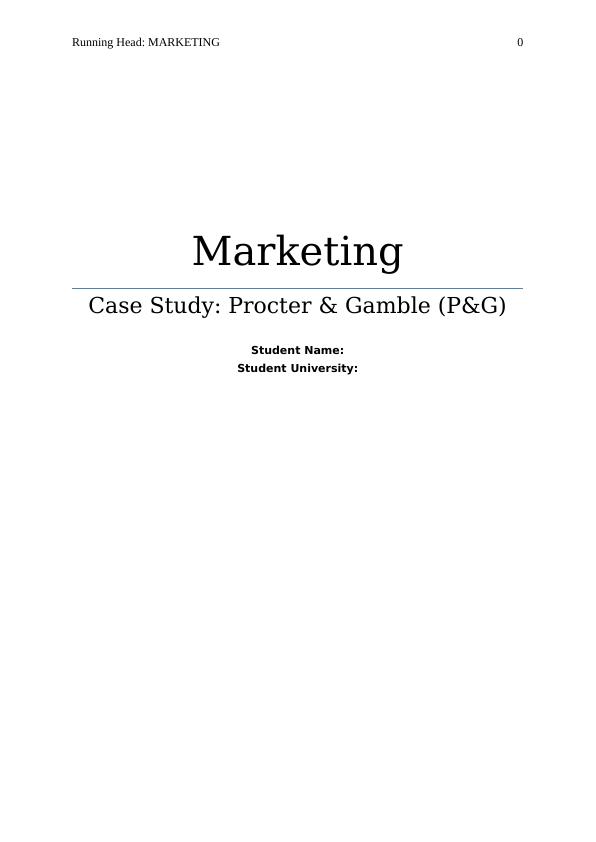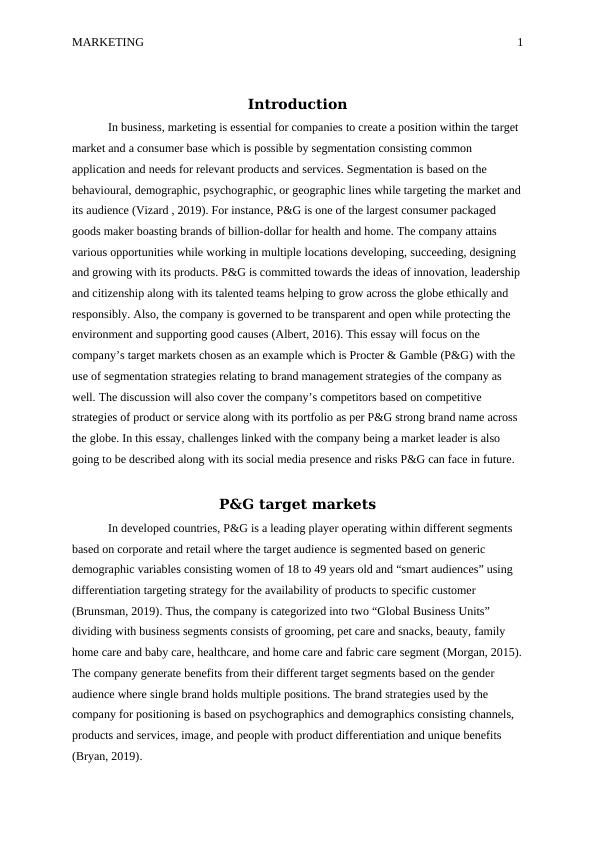Marketing | Definition, Tactics, Purpose
7 Pages1811 Words19 Views
Added on 2022-08-26
Marketing | Definition, Tactics, Purpose
Added on 2022-08-26
ShareRelated Documents
Running Head: MARKETING 0
Marketing
Case Study: Procter & Gamble (P&G)
Student Name:
Student University:
Marketing
Case Study: Procter & Gamble (P&G)
Student Name:
Student University:

MARKETING 1
Introduction
In business, marketing is essential for companies to create a position within the target
market and a consumer base which is possible by segmentation consisting common
application and needs for relevant products and services. Segmentation is based on the
behavioural, demographic, psychographic, or geographic lines while targeting the market and
its audience (Vizard , 2019). For instance, P&G is one of the largest consumer packaged
goods maker boasting brands of billion-dollar for health and home. The company attains
various opportunities while working in multiple locations developing, succeeding, designing
and growing with its products. P&G is committed towards the ideas of innovation, leadership
and citizenship along with its talented teams helping to grow across the globe ethically and
responsibly. Also, the company is governed to be transparent and open while protecting the
environment and supporting good causes (Albert, 2016). This essay will focus on the
company’s target markets chosen as an example which is Procter & Gamble (P&G) with the
use of segmentation strategies relating to brand management strategies of the company as
well. The discussion will also cover the company’s competitors based on competitive
strategies of product or service along with its portfolio as per P&G strong brand name across
the globe. In this essay, challenges linked with the company being a market leader is also
going to be described along with its social media presence and risks P&G can face in future.
P&G target markets
In developed countries, P&G is a leading player operating within different segments
based on corporate and retail where the target audience is segmented based on generic
demographic variables consisting women of 18 to 49 years old and “smart audiences” using
differentiation targeting strategy for the availability of products to specific customer
(Brunsman, 2019). Thus, the company is categorized into two “Global Business Units”
dividing with business segments consists of grooming, pet care and snacks, beauty, family
home care and baby care, healthcare, and home care and fabric care segment (Morgan, 2015).
The company generate benefits from their different target segments based on the gender
audience where single brand holds multiple positions. The brand strategies used by the
company for positioning is based on psychographics and demographics consisting channels,
products and services, image, and people with product differentiation and unique benefits
(Bryan, 2019).
Introduction
In business, marketing is essential for companies to create a position within the target
market and a consumer base which is possible by segmentation consisting common
application and needs for relevant products and services. Segmentation is based on the
behavioural, demographic, psychographic, or geographic lines while targeting the market and
its audience (Vizard , 2019). For instance, P&G is one of the largest consumer packaged
goods maker boasting brands of billion-dollar for health and home. The company attains
various opportunities while working in multiple locations developing, succeeding, designing
and growing with its products. P&G is committed towards the ideas of innovation, leadership
and citizenship along with its talented teams helping to grow across the globe ethically and
responsibly. Also, the company is governed to be transparent and open while protecting the
environment and supporting good causes (Albert, 2016). This essay will focus on the
company’s target markets chosen as an example which is Procter & Gamble (P&G) with the
use of segmentation strategies relating to brand management strategies of the company as
well. The discussion will also cover the company’s competitors based on competitive
strategies of product or service along with its portfolio as per P&G strong brand name across
the globe. In this essay, challenges linked with the company being a market leader is also
going to be described along with its social media presence and risks P&G can face in future.
P&G target markets
In developed countries, P&G is a leading player operating within different segments
based on corporate and retail where the target audience is segmented based on generic
demographic variables consisting women of 18 to 49 years old and “smart audiences” using
differentiation targeting strategy for the availability of products to specific customer
(Brunsman, 2019). Thus, the company is categorized into two “Global Business Units”
dividing with business segments consists of grooming, pet care and snacks, beauty, family
home care and baby care, healthcare, and home care and fabric care segment (Morgan, 2015).
The company generate benefits from their different target segments based on the gender
audience where single brand holds multiple positions. The brand strategies used by the
company for positioning is based on psychographics and demographics consisting channels,
products and services, image, and people with product differentiation and unique benefits
(Bryan, 2019).

MARKETING 2
Competitors of P&G
P&G has the competitive advantage of strong product line and its market presence in
relation to numerous brands within particular categories of product. Also, the company sells
its products in over 180 countries as per fully owned business units with a successful
distribution network. P&G competitors are Colgate-Palmolive, Unilever and Johnson &
Johnson following multi-brand strategy. The company uses generic strategy of differentiation
for competitive advantage to attract target customers based on the value and quality of
consumer goods (Young, 2018). The competitive strategy for product or service used is of
acquisition along with strengthening its position by making alliance and entering in strategic
agreements based on P&G’s position within the target markets and increasing market share.
The advantages of P&G’s competitive advantage are by the company’s profitability as per
improvement in its gross profit margin efficiently with the impact of higher commodity costs.
The company’s marketing strength where P&G invests almost $5 billion in advertising every
year, and its cash returns with the raise in dividend yield (Kalogeropoulos D. , 2017). The
only disadvantage P&G face is at the time of economic weakness and consumers are forced
to switch towards cheaper options.
Portfolio of P&G
P&G divides its business into five segments globally comprising vast portfolio of
oral, hair, feminine, personal and skin, bay care product, and family lines. The brands of
P&G get a way of moving towards “creative partnerships” aiming to have an editorial instead
of pure tone of promotion in its marketing (Handley, 2019). P&G follows multi-brand
approach as well associated with facing challenges where the brand can be affected. One of
the challenges is scandal of undoing good customer relationships having with other brand’s
customers impacting the company’s market positioning and financial status adversely. Any
minor mistake committed by the company can lead to negative publicity due to consumers’
feedback. There is an issue of lack of price sensitivity as well which might hampers the
growth of company in long-term. Due to facing such challenges, competitors like Unilever
gains market share significantly while making improvisation in market positioning and
successful innovations along with threatening the market leadership of P&G (Hobbs, 2015).
Thus, this conclude the retailer dependence increment along with brand’s internal
competition, brand dilution, decline in profits within FMCG markets, and giving market
share a priority more than profits.
Competitors of P&G
P&G has the competitive advantage of strong product line and its market presence in
relation to numerous brands within particular categories of product. Also, the company sells
its products in over 180 countries as per fully owned business units with a successful
distribution network. P&G competitors are Colgate-Palmolive, Unilever and Johnson &
Johnson following multi-brand strategy. The company uses generic strategy of differentiation
for competitive advantage to attract target customers based on the value and quality of
consumer goods (Young, 2018). The competitive strategy for product or service used is of
acquisition along with strengthening its position by making alliance and entering in strategic
agreements based on P&G’s position within the target markets and increasing market share.
The advantages of P&G’s competitive advantage are by the company’s profitability as per
improvement in its gross profit margin efficiently with the impact of higher commodity costs.
The company’s marketing strength where P&G invests almost $5 billion in advertising every
year, and its cash returns with the raise in dividend yield (Kalogeropoulos D. , 2017). The
only disadvantage P&G face is at the time of economic weakness and consumers are forced
to switch towards cheaper options.
Portfolio of P&G
P&G divides its business into five segments globally comprising vast portfolio of
oral, hair, feminine, personal and skin, bay care product, and family lines. The brands of
P&G get a way of moving towards “creative partnerships” aiming to have an editorial instead
of pure tone of promotion in its marketing (Handley, 2019). P&G follows multi-brand
approach as well associated with facing challenges where the brand can be affected. One of
the challenges is scandal of undoing good customer relationships having with other brand’s
customers impacting the company’s market positioning and financial status adversely. Any
minor mistake committed by the company can lead to negative publicity due to consumers’
feedback. There is an issue of lack of price sensitivity as well which might hampers the
growth of company in long-term. Due to facing such challenges, competitors like Unilever
gains market share significantly while making improvisation in market positioning and
successful innovations along with threatening the market leadership of P&G (Hobbs, 2015).
Thus, this conclude the retailer dependence increment along with brand’s internal
competition, brand dilution, decline in profits within FMCG markets, and giving market
share a priority more than profits.

End of preview
Want to access all the pages? Upload your documents or become a member.
Related Documents
Introduction to Marketing Task | Studylg...
|13
|2620
|20
Integrated Marketing Communication - Analysis and Practiceslg...
|8
|1388
|66
Managementlg...
|10
|3210
|68
Strategic Management of Procter & Gamble Toiletrieslg...
|18
|4466
|499
Marketing Strategy for Ariel Detergent: PESTLE and SWOT Analysis, USP, and Promotional Strategieslg...
|17
|5037
|480
Strategic Management for Procter & Gamble: SWOT and PESTLE Analysislg...
|21
|5987
|326
